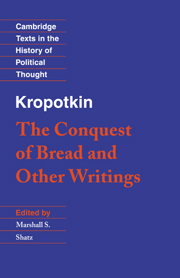Book contents
- Frontmatter
- Contents
- Introduction
- Principal events in Kropotkin's life
- Bibliographical note
- Biographical synopses
- The Conquest of Bread
- Other writings
- ‘Western Europe’, from Memoirs of a Revolutionist
- ‘Anarchism’, from The Encyclopaedia Britannica
- Kropotkin on the Russian Revolution
- Index
- Cambridge Texts in the History of Political Thought
Kropotkin on the Russian Revolution
Published online by Cambridge University Press: 05 June 2012
- Frontmatter
- Contents
- Introduction
- Principal events in Kropotkin's life
- Bibliographical note
- Biographical synopses
- The Conquest of Bread
- Other writings
- ‘Western Europe’, from Memoirs of a Revolutionist
- ‘Anarchism’, from The Encyclopaedia Britannica
- Kropotkin on the Russian Revolution
- Index
- Cambridge Texts in the History of Political Thought
Summary
‘Message to the Workers of the Western World’, 10 June 1920 Two letters to Lenin, 4 March 1920 and 21 December 1920 ‘What Is to Be Done?’ 23 November 1920
Kropotkin's return to Russia in 1917 after four decades in emigration was bittersweet. No longer able to play an active political role, he could only bear witness as the long-anticipated revolution gave way to the one-party rule of the Bolsheviks. A sampling of his brief pronouncements in his last years shows him trying to come to terms with a phenomenon that aroused both his brightest hopes and his worst fears.
‘Message to the Workers of the Western World’ was given to the members of a British Labour Delegation that came to visit him on 10 June 1920. It is reprinted from The Labour Leader of 22 July 1920. The two letters to Lenin are reprinted from Martin A. Miller, ed., Selected Writings on Anarchism and Revolution: P. A. Kropotkin (Cambridge, Mass., and London: MIT Press, 1970), pp. 335–39. ‘What Is to Be Done?’, dated 23 November 1920, was published in Berlin in 1923. Reprinted here is the somewhat abridged translation which appears under the title ‘What to Do?’ in Roger N. Baldwin, ed., Kropotkin's Revolutionary Pamphlets (New York and London: Benjamin Blom, 1927; reissued 1968), pp. 256–59.
Message to the Workers of the Western World
Dmitrov, 10 June 1920
I have been asked whether I have not some message to send to the working men of the Western world? Surely, there is much to say about the current events in Russia, and much to learn from them.
- Type
- Chapter
- Information
- Kropotkin: 'The Conquest of Bread' and Other Writings , pp. 248 - 260Publisher: Cambridge University PressPrint publication year: 1995



